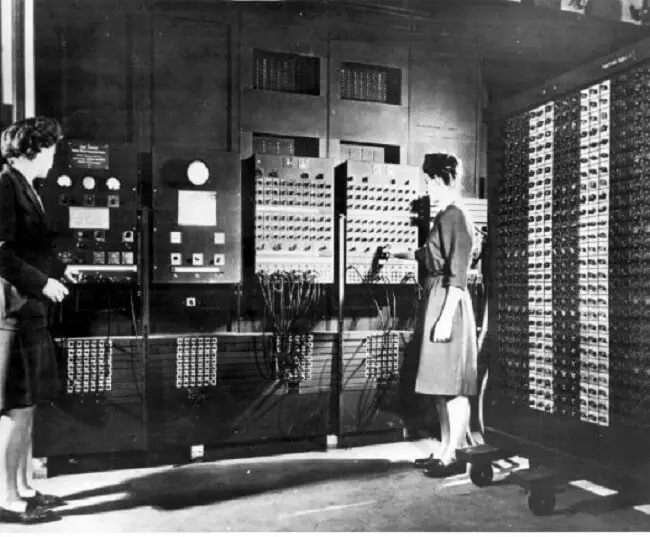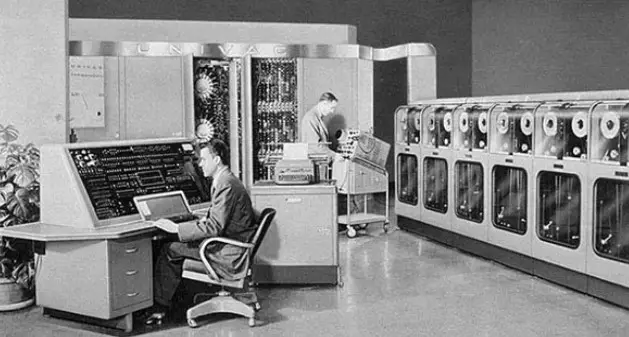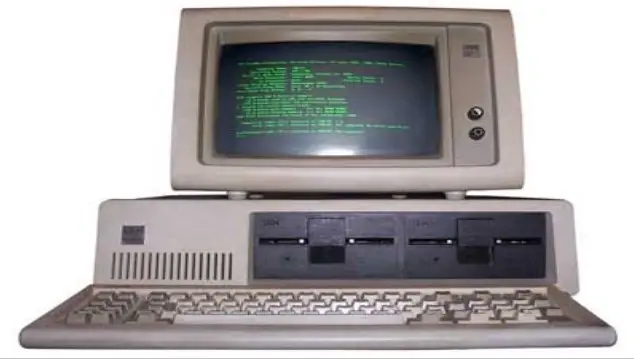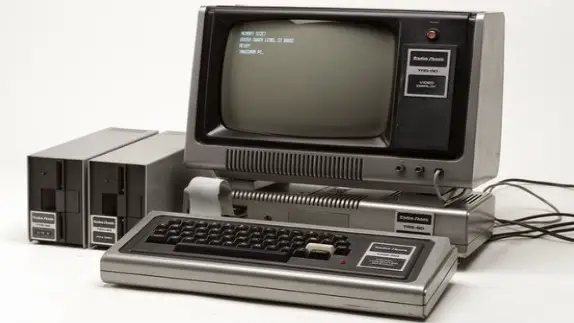➤ Computer Generation
➤ First Generation
➤ Second Generation
➤ Third Generation
➤ Fourth Generation
➤ Fifth Generation
➤ Basic of Programming
➤ Computer Systems
➤ Virtual Machine
➤ Advantages of Open Source Software
➤ Open Source Software Advantages and Disadvantages
➤ Applications of Computer in Business
In the field of computers, technology is changing all the time. The generation of computers is a special change in computer technology. In the beginning, the generation word was used to distinguish between varying hardware technologies. At that time there were many changes in hardware compared to software. Nowadays both hardware and software are changing very fast. Therefore, both hardware and software are important in a generation change.
There are five computer generations. There has been a big change in every generation. We will discuss each generation in detail.
First Generation of Computer
The first generation of computers was based on vacuum tube technology. The batch processing operating system was used in the first generation of computers. At the time of the first generation of computers, programming languages were not developed. At that time only machine code was used. All input methods were a machine language, and it was known as 1GL (first generation languages). The 1GL was the lowest-level or machine level language.
The 1st generation of computers was not made for the general markets. The computers of the first generation were very expensive and only the big organizations or rich people were able to buy them.
First Generation Computer Examples
Examples of first generation computers are:-
- ENIAC
- EDSAC
- EDVAC
- UNIVAC
- IBM-701
- IBM-650.
Features of First Generation Computer
The first generation computers having following features,
- Vacuum tube technology
- Very expensive
- Consumed a high electricity
- Generated a large amount of heat
- Large size
- Only machine language can be used
- The device was working very slow
- Incredible
- Non-portable
- AC requirement in system
Advantage of First Generation Computer
The main advantage of the first generation computers were,
- At that time only electronic components were available. The computer was made by a vacuum tube.
- These computers could solve general calculations.
- At that time computer technology was the first step in the world, so the computer was very useful for the next generation of computers.
- These computers were used in the calculation related to the development of atomic bombs.
Disadvantages or Limitations
Since it was the very first generation of computers that’s why it had many limitations and disadvantages compared to the next generations. The limitations of the first generation of computers are,
- This computer was limited to large calculations and general calculations.
- The first generation computer was solving only one problem at a time, it was not able to understand the multi-tasking work.
- This computer had taken the time of days or weeks to set up a new problem.
- There was very small storage in computer memory.
- Computers of that time were very slow, very large, and highly expensive.
- These computer systems used a great amount of electricity and produced a lot of heat. The more heat was often the cause of the spoiler of the computer.
Following are the disadvantages of the first generation of computers,
- The first generation of computers was very expensive.
- These computers were very large in size. The computer took 15,000 square feet of space.
- The weight of this computer was 30 tons. The computer seemed like a whole room.
- Too much electricity consumed by these computers.
- These computers had produced high amounts of heat.
- The vacuum tube was used in this computer system, so a large cooling system was required.
- In this computer, only small amounts of information could be store.
Second Generation of Computer
The second-generation computers were developed during 1959 to 1965. Mainly transistors were used in the 2nd generation computer. In 1947, Bell Labs invented the transistor but it was not seen to have widespread use in computers until the late 1950s. Second-generation computers were cheaper, consumed less electricity, small in size, and faster than the first generation of computers.
The second-generation computers used batch processing and multiprogramming operating systems. Assembly languages and more high-level programming languages such as FORTRAN, COBOL were used as programming languages. New types of careers like programmers, analysts, and computer systems experts and the entire software industry started from the second generation of computers.
Examples of Second Generation Computers
Many computers were developed in the second generation of computers. Some popular second-generation computer name,
- IBM 1401
- Honeywell 400
- IBM 1620
- CDC 1604
- IBM 7094
- CDC 3600
- UNIVAC 1108
Features of Second Generation Computer
The main characteristics and features of second generation computers are,
- Use of transistors in the computer system
- Smaller size as compared to the first-generation computer
- Consumed less electricity
- Generated less heat
- Reliable in comparison to first-generation computers
- Supported machine and assembly languages
- AC required
- Faster than first-generation computers
- Still very costly
Advantages of Second Generation Computer
Over the first-generation computer, the second-generation computer having many advantages,
- Due to the presence of transistors in place of vacuum tubes, the electron component size decreased. It reduced the size of the computer as compared to the first generation of computers. Therefore, it became easier to use the computer.
- Second-generation computers consumed less energy and did not produce more heat as compared to the first generation of computers.
- The assembly language was used for input. Therefore, the machine became easier to use.
- Better speed, faster data calculations.
- Better portability as compared to the first generation computer.
Disadvantages of second generation computers
Compared to next-generation computers, the second generation computers had some disadvantages,
- AC was required in the computer system.
- Only used for specific purposes & important work.
- Constant maintenance was required of the computer.
- It was still very expensive, but cost less than the first generation computer.
Third Generation of Computer
The time period of the third (3rd) generation computer was 1965-1971. Mainly transistors were used in the second generation of computers to develop computers, but in the third generation of computers, Integrated circuits were introduced.
Due to the use of integrated circuits, the computer was smaller in size, efficient, and more reliable. Third-generation computers having remote processing, time-sharing, and multiprogramming operating systems. Many programming languages like COBOL, PASCAL PL/1, FORTRAN-2 to 5, and ALGOL-68 were also used in the 3rd generation computers.
Punch cards, printouts, and monitors were used as input and output devices. punch cards and printouts were switched to keyboards and the monitor was added to the operating system. The Digital Equipment Corporation introduced the first commercial computer.
Third Generation Computer Name
Many computers have been developed in the 3rd generation. The name of popular third-generation computers are,
- Honeywell-6000 series
- IBM-360 series
- IBM-370/168
- PDP (Personal Data Processor)
- TDC-316
- ICL 2900
Features and Characteristics of Third Generation Computer
Compared to the first and second-generation computer the main features/characteristics of third-generation computers are,
- Integrated Circuits were used
- Consumed less power
- Produced less heat
- AC required in the computer system
- Supported multiprogramming operating systems
- Used high-level language
- Smaller in size
- Faster work compared to previous generation computer
- Lesser maintenance
- More reliable
- Cheaper
Advantages of 3rd generation of computer
There were many advantages of the 3rd generation of computers over the previous generation of computers.
- Due to the presence of Integrated Circuits in the computer, the size of the computer becomes small.
- Operating systems were used in the third generation computers.
- Big storage capacity was there.
- Punch cards, keyboard, and mouse are used in these computers.
- Better performance as compared to previous generation computers.
- Better resource management
- Concept of time-sharing
- High-level language and Multiprogramming language was used in this generation computers.
- More reliable as compared to previous generation computers.
- Faster working power
- Generated less heat as compared to previous generation computers
- This generation computers were cheaper than the previous generation computers.
Disadvantages
Some disadvantages were there and due to this fourth generation of computers were introduced. Mainly disadvantages are,
- Due to the use of Integrated Circuits in the computer, it is difficult to maintain.
- The high technology required for the manufacturing of IC chips.
- Third-generation computers need AC for cooling the system.
Fourth Generation of Computer
The time period of the fourth generation of computers was 1971-1980. The fourth generation of computers was developed using VLSI (Very Large Scale Integrated) Circuit. Therefore, they are also known as microprocessors. A microprocessor was used for logical and arithmetic functions on a computer. 5000 transistors and other circuit elements were on a single chip. Therefore, it was possible to build a microcomputer in this generation.
The First Personal Computer (PC) was developed by IBM. The use of PCs increased in the fourth generation. Fourth-generation computers were supercomputers compared to the previous generation computers. Many high-level programming languages like C, C++, DBASE, etc., were used in computers. Many different applications like Data management, report generation, GUI development, mathematical optimization, and web development were included in the fourth generation. Also, a Networking system was added in this generation of computers.
Features of Fourth Generation Computer
The main features of fourth generation computer are,
- Very Large Scale Integrated (VLSI) Circuits used in these computers
- Use of Personal Computer (PC)
- Pipeline processing in the computer system
- The great development in the field of networks
- Concept of the Internet was introduced
- Time-sharing added in computer Distributed operating system used
- High-level language like C, C++, DBASE, etc., were used
- Powerful and reliable
- Consumed less electricity
- Produced negligible heat
- No AC required in computer
- Very small size and portable
- Computer become easily available in the market
- Very cheap as compared to previous generation computers.
Advantages of Fourth Generation Computer
There were many advantages to fourth generations computers. The main advantages are,
- Due to the VLSI technology, the computer was very small in size.
- Distributed operating systems and high level language like C, C++, DBASE etc., were used in computers. Therefore, computers were more powerful and faster work.
- Concept of the Internet was introduced.
- Great development in the field of networks.
- Time-sharing was also added in fourth generation computers.
- Computers were Portable and very Reliable.
- Use of Personal Computer (PC) was increased in the fourth generation.
- Heat generated was negligible. Therefore, no AC is required in the computer system.
- Computers were very cheap in the fourth generation.
- Computers become easily available in the market.
Disadvantages of fourth-generation computers
- Due to the use of IC (Integrated Circuits), AC is required in many cases.
- The Design of microprocessors was very complex.
- The advanced technology was required for the manufacturing of IC.
5th Generation Of Computer
The time period of the 5th generation of computer is 1980 onwards. In 1982, the first computer of the fifth generation was developed by Japan’s Ministry of International Trade and Industry. In this computer system, ULSI (Ultra Large Scale Integration) technology was used in place of VLSI (Very-large-scale integration) technology.
The fifth-generation computer was based on Artificial intelligence (AI) software. Artificial intelligence describes the medium and way of making computers like humans. This was to provide a platform for future developments in artificial intelligence. This is an emerging branch in computer science.
All high-level programming languages such as C/C++, Python, Java, etc., used to be done from the early fifth generation. Logic programming and Massively parallel computing were used in computers. Many types of new technology like Voice recognition, parallel processing, superconductors, quantum computation, and nanotechnology were developed in the fifth generation. The fifth-generation computer responds to natural language input and is capable of learning and self-organization. These 5th generation computers were very powerful and more programmer-friendly compared to previous generation computers.
Examples of 5th Generation Computer
- Desktop
- Laptop
- NoteBook
- UltraBook
- Chromebook
Characteristics of Fifth Generation Computers
The main characteristics of the fifth generation computers are,
- ULSI technology used in the computer system
- Developed based on artificial intelligence
- Parallel Processing used in computer
- high-level programming languages are used
- Voice recognition features added
- Advancement in Superconductor technology
- Quantum computation and nanotechnology used
- Development of Natural language processing
- very powerful and faster work
- More user-friendly
- Small size
- cheaper rates
Advantages of 5th Generation Computers
Compared to the previous generation of computers the main advantages of the 5th generation computers are,
- It is more reliable and works faster.
- It provides multimedia features.
- High-level programming languages have been used in computers. Therefore, the computer is very easy to use.
- It is available in different sizes.
- This computer is more user-friendly.
- Voice recognition made it easy to use the computer.
Disadvantages
New technology and artificial intelligence may become a problem for humans in future.
If you enjoyed this post, share it with your friends. Do you want to share more information about the topic discussed above or do you find anything incorrect? Let us know in the comments. Thank you!




